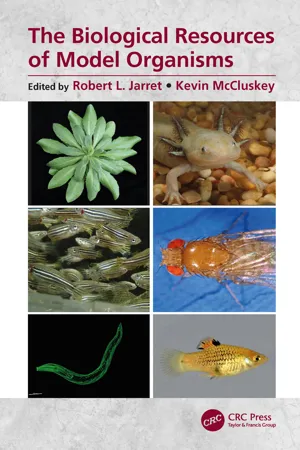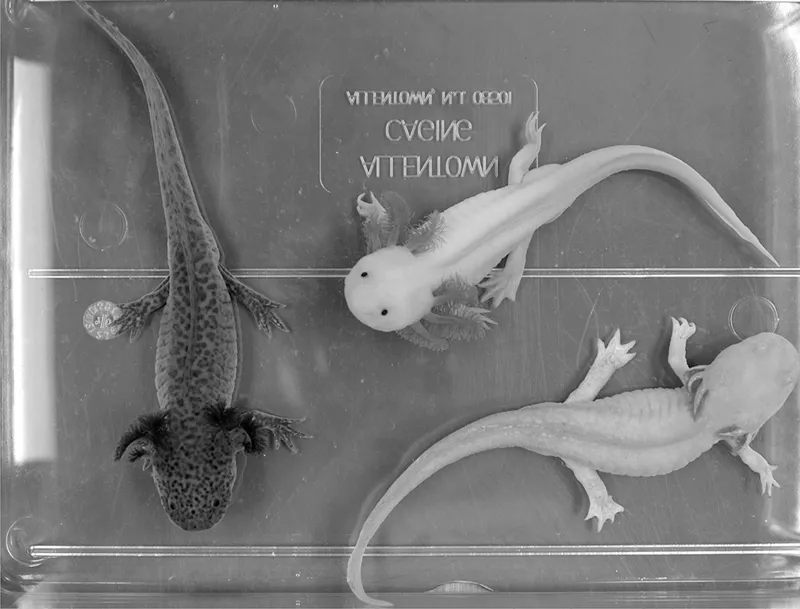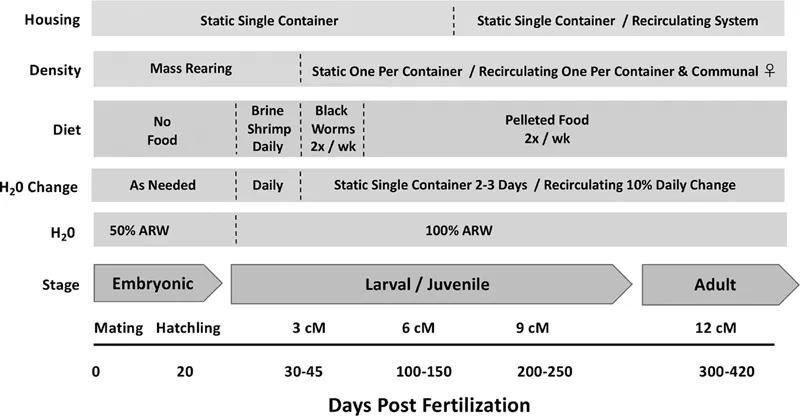![]()
1 | Introduction to the Laboratory Axolotl and the Ambystoma Genetic Stock Center S. Randal Voss, Laura Muzinic and Chris Muzinic |
CONTENTS
Introduction
The Axolotl Model Organism
The Ambystoma Genetic Stock Center
Website
Axolotl Stocks
Extrinsic Environmental Variables—Ensuring Reproducible Axolotl Research
Water Quality
Housing and Diet
Temperature and Light
Conclusions
References
Abstract: Laboratory populations of the Mexican axolotl have been sustained for over 150 years in support of biological research. With recent advances in genetic and genome resource development, the axolotl is attracting considerable attention from new researchers, especially in the area of tissue regeneration. To reduce the learning curve and generally facilitate broader use of the axolotl, we introduce the Ambystoma Genetic Stock Center (AGSC), a research resource center that sustains and makes axolotl stocks available to researchers nationally and internationally. In order to assist researchers who are unfamiliar with axolotl biology, we describe our methods of husbandry, highlighting water quality and extrinsic environmental variables that the stock center controls and monitors to ensure axolotl health and well-being.
INTRODUCTION
In this chapter we introduce the primary salamander model in laboratory research, the Mexican axolotl (Ambystoma mexicanum). We also introduce the Ambystoma Genetic Stock Center (AGSC), which is funded by the National Institutes of Health (NIH) to provide axolotls in support of biomedical research. Our objective is to provide useful information to those that use, or are planning to use, axolotls in research and educational activities.
THE AXOLOTL MODEL ORGANISM
The axolotl has a deep and rich history as a laboratory model organism. Present day laboratory populations trace their ancestry back to an original collection of 34 axolotls that were shipped to Paris in 1863 from aquatic habitats near present day Mexico City (Reiß et al. 2015). Over the next few decades, axolotls were propagated in laboratories across Europe and used to study questions related to development and evolution, and these studies helped to originate the field of experimental zoology. During the twentieth century, axolotls factored prominently in studies of embryonic and post-embryonic development, sex determination, cloning, and tissue regeneration (Smith and Smith 1971, Voss et al. 2009). Today, axolotls are attracting increased attention from biomedical researchers due to their unrivaled ability to regenerate entire organs. They share the body plan of tetrapod vertebrates (Figure 1.1) and are unique in their ability to regenerate a broad spectrum of damaged organs throughout life, including limbs, spinal cord, brain, lens, skin, ovary, and heart (Amamoto et al. 2016, Cano-Martínez et al. 2010, Erler et al. 2017, Haas and Whited 2017, Ponomareva et al. 2015, Suetsugu-Maki et al. 2012, Tazaki et al. 2017, Yokoyama et al. 2018). Understanding the cellular and genetic mechanisms by which axolotls regenerate tissues could have clinical significance for treating human trauma, disease, and aging.
FIGURE 1.1 (See color insert.) Three different Mexican axolotl stocks that differ in their pigment pattern. The wildtype axolotl has three different pigment cells (xanthophores, melanophores, and iridophores) that combine to yield a dark greenish coloration (left). The white axolotl (center) is homozygous for a mutated endothelin 3 gene that results in the loss of dark melanocytes soon after hatching. The golden albino (right) has an abundance of yellow xanthophores but lacks a functional tyrosinase gene for melanin production. (Courtesy of Lee Thomas.)
In several ways, the axolotl was pre-adapted to become a laboratory model. Axolotls are members of the Tiger salamander complex, a group of ambystomatids that exhibit considerable variation in life history and modes of development (Shaffer and Voss 1996, Voss et al. 2015). Some species undergo a metamorphosis after an aquatic larval phase and gain traits for terrestrial life. Other species like the axolotl are paedomorphic and remain in the aquatic habitat throughout their life cycle. While it is possible to rear metamorphic forms in the lab, the axolotl’s totally aquatic life history greatly simplifies laboratory culture. Moreover, axolotls are capable of breeding more than one time a year and produce considerably more offspring per spawn than metamorphic forms, which are seasonal breeders. Axolotls are ideal laboratory models because they can be propagated as captive managed populations that are self-sustaining and capable of providing living stocks (embryos, larvae, juveniles, and adults) to meet the needs of a research community. In contrast, other salamanders that are used in biomedical research are annual breeders that are harvested from natural populations. In particular, newts (Notophthalmus) and Tiger salamanders (A. tigrinum) continue to be harvested from natural populations in the US for regeneration and retina electrophysiology preparations, respectively. Because amphibians in general are declining around the world, it is difficult to justify the collection of salamanders from natural populations for laboratory studies when axolotl stocks are available from a sustainable, captive-bred population (Baddar et al. 2015).
Axolotls are interesting research models because they maintain juvenile morphology throughout their life. Unlike their ancestors, axolotls typically do not undergo metamorphosis and transition to land during their life cycles. This mode of development is called paedomorphosis (Gould 1977) and the evolution of paedomorphosis is associated with changes in neuroendocrine axes that regulate metamorphosis (Johnson and Voss 2013). Paedomorphosis evolved so recently in axolotls that the ancestral metamorphic mode of development can be induced by adding thyroid hormone to an axolotl’s rearing water (Page and Voss 2009).
Because of the recent development of a chromosome scale genome assembly (Smith et al. 2019) and tools to manipulate gene function (Fei et al. 2017, Flowers et al. 2014, Khattak and Tanaka 2015, Khattak et al. 2014, Woodcock et al. 2017), it is now possible to investigate the molecular basis of thyroid hormone signaling and paedomorphosis. Indeed, the impact of having an axolotl genome assembly on future research efforts cannot be overstated. The assembly of the enormous ~30 Gb axolotl genome enables sequence-based methods of inquiry that are typical of genetic model organisms. For example, researchers can access gene models from which to identify mutants and design molecular tools for PCR, reporter constructs, and genome editing. Additionally, information from coding and non-coding regions enriches our understanding of amphibian genome structure and function, and provides context for annotating and interpreting transcriptomic, genomic, and epigenetic datasets. Further improvements in the quality of the assembly and databases from which to access information will facilitate broader use of the axolotl in biomedical research.
THE AMBYSTOMA GENETIC STOCK CENTER
Almost all of the domesticated axolotls in the world trace their ancestry to the AGSC at the University of Kentucky, which is funded by the NIH (P40-OD019794) to provide axolotls in support of research and educational efforts. This collection is irreplaceable because decades of inbreeding have yielded homogeneous genetic stocks that thrive in the lab (Voss and Kump 2016). The collection provides standard living stocks (embryos, larvae, and adults) and supplies to culture axolotls in investigator labs. By supplying living material from a single facility, the AGSC minimizes the need for smaller satellite collections. This effectively reduces the cost of animal use for investigators, and yearly expenses for the entire research community are greatly reduced because axolotl material is obtainable on demand. Many AGSC users are located at institutions that do not have the equipment, expertise, or dedicated space to rear axolotls. For investigators that maintain relatively large numbers of axolotls, the AGSC serves as a back-up facility to replenish stocks and as a source of genetic variation to maintain the vigor of strains. For investigators that need early stage embryos, the AGSC provides breeders with advice about performing crosses and maintaining axolotls. Thus, the AGSC serves the needs of investigators in a variety of ways, and it is the historical with contemporary source of axolotl stocks in the world.
The AGSC has approximately 3000 sq ft for maintaining approximately 1000 juvenile and adult axolotls, and thousands of embryos and larvae. The AGSC primarily functions as a custom order business as it is too costly to maintain all axolotl stocks in sufficient numbers to meet immediate user needs. Thus, it is important that users plan their experiments well ahead of time as it can take several months to produce some stocks and a year to produce adults (Figure 1.2).
FIGURE 1.2 Diagram illustrating the integration of the axolotl life history in the laboratory with husbandry variables.
WEBSITE
Users initiate the purchasing process by first completing an online registration form that is available from the AGSC webpage (http://www.ambystoma.org/genetic-stock-center). After registering, users are put into contact with AGSC staff to discuss their order and the timeframe for receiving purchased stocks.
In addition to supplying axolotl stocks and associated husbandry supplies, the AGSC serves as an informatics hub where investigators obtain information about the collection, technical procedures, potential collaborators, and research findings. Several times each week, AGSC staff respond to user questions and every effort is made to provide answers to queries within 24 hours. An independent website was developed for the AGSC to ensure flexibility and control of web and database design, networking, and file storage. Information on the AGSC website provides researchers with a list of available stocks, pricing, and instructions on how to order axolotls and related supplies. Also, the AGSC website provides information concerning axolotl husbandry, development, and genetics. The AGSC website is accessible through Sal-Site (Baddar et al. 2015) which was developed under NIH-funding (R24-OD010435) to distribute genome-based informatics to the research community. A newsletter (Axolotl) is distributed annually to keep the community informed about axolotl services, new advances in the field, NIH policies and opportunities, and techniques (Keinath et al. 2018, Voss and Kump 2016).
AXOLOTL STOCKS
The AGSC maintains a variety of axolotl stocks of all life stages, as well as mutants and transgenics. Each stock is associated with a unique Research Resource Identifier (RRID) number (Table 1.1) as recommended by the Resource Identification Initiative at SciCrunch (SciCrunch.org). The RRID is a database-driven initiative that seeks to ‘barcode’ all of the critical reagents and tools that are used in the course of scientific research with RRIDs. In addition to wild types, there are three pigment mutants (melanoid, white, albino), two lethal mutants (cardiac and short toes), one sterile mutant (eyeless), and two transgenics (green fluorescent protein and red fluorescent protein) that were donated by Elly Tanaka (IMP, Vienna). The color mutants and ubiquitously expressing transgenic axolotls facilitate tissue grafting and cell lineage experiments. Three of the mutants were recently cloned (Smi...


